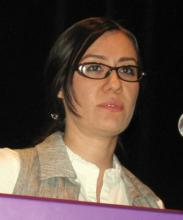DENVER - Intermittent theta burst stimulation of the cerebellar vermis in patients with refractory schizophrenia is a safe, noninvasive therapy that resulted in significantly improved negative symptoms, cognition, and mood in a proof-of-concept study.
The results of this small pilot study are potentially important, because current treatments for the negative symptoms of schizophrenia are so inadequate, Dr. Asli Demirtas-Tatlidede observed in presenting the study results at the annual meeting of the American Neuropsychiatric Association.
Theta burst stimulation (TBS) is a newer form of transcranial magnetic stimulation that modulates the activity of the dysfunctional cerebrocerebellar neural circuits that are present in schizophrenia in a shorter period of time, and with more potent and longer-lasting effects. TBS can be viewed as a noninvasive analogue to stimulation via implanted electrodes, a treatment that has shown efficacy for epilepsy, schizophrenia, and uncontrollable aggression, explained Dr. Demirtas-Tatlidede of Harvard Medical School, Boston.
She reported on eight patients with treatment-refractory schizophrenia, all right handed, who spent a week at the clinical research center at Beth Israel Deaconess Medical Center in Boston, where they underwent close monitoring as they received 10 sessions of TBS.
The TBS was administered twice daily on 5 consecutive days. Brain MRI and stereotactic localization were employed in order to direct the TBS to the cerebellar vermis. Psychiatric evaluations and comprehensive neuropsychological testing were done before and after TBS, and again 1 week after the final session.
The safety results were completely reassuring. There were no instances of cognitive decline, seizures, psychiatric or neuropsychological worsening, or any serious adverse events. Side effects were limited to brief, mild occipital headaches and small decreases in diastolic blood pressure lasting fewer than 5 minutes post TBS, both deemed probably treatment related.
In terms of efficacy end points, patients showed significant improvement in the PANSS (Positive and Negative Symptom Scale) negative subscale, with a mean 19% reduction from baseline. Participants also showed a significant improvement in mood as reflected in scores on the Calgary Depression Scale for Schizophrenics, as well as on self-reported visual analog scales for happiness and sadness.
Neuropsychological testing showed significantly fewer omissions in the working memory and interference conditions of the CPT (Continuous Performance Test). Patients also demonstrated a longer spatial span and better delay organization on the ROCF (Rey-Osterrieth Complex Figure) test during follow-up.
It has become apparent only quite recently that the limbic cerebellum – that is, the cerebellar vermis and fastigial nucleus – is closely involved in the regulation of affect and emotion. These structures are connected with the amygdala, hippocampus, hypothalamus, periaqueductal gray matter, and the limbic regions of the frontal and temporal lobes. The mechanism by which TBS brings improvement in negative symptoms, mood, and cognition remains unclear, but it is plausible that by stimulating the vermis, the treatment activates a dysfunctional cerebellum, enabling it to perform its normal function of correcting errors in thought and emotion, she continued.
The TBS was applied at 100% of active motor threshold intensity.
In response to an audience question as to whether these patients with treatment-refractory schizophrenia liked TBS therapy, Dr. Demirtas-Tatlidede’s senior co-investigator Dr. Jeremy D. Schmahmann replied that this was definitely the case. Indeed, one patient refused to accept that the study was over and has insisted on returning for TBS at monthly intervals.
"Her life has turned around. This is anecdotal, of course, but it’s extremely impressive," commented Dr. Schmahmann, professor of neurology at Harvard, and director of the ataxia unit and of the laboratory of neuroanatomy and cerebellar neurobiology at Massachusetts General Hospital.
Planning is underway for larger randomized, controlled studies incorporating a sham-stimulation control arm.
The pilot study was funded by the National Center for Research Resources, the National Institutes of Health, and several charitable foundations. Dr. Demirtas-Tatlidede and Dr. Schmahmann declared having no financial conflicts.

